LeBron James' Liquid Nitrogen Freezing Chamber Is All The Rage, Now Here's The Science Behind It

For those of you who have been missing the 2015 NBA Playoffs, LeBron James has been dealing with some nagging injuries that he has refused to let hinder his performance (trust me, watch one press conference and he’ll let you know all about it). As the Cleveland Cavaliers enter the final stretch of the playoffs with an injured Kyrie Irving and no Kevin Love, LeBron’s health has been on the mind of every curious NBA fan. Thankfully, the Cavs’ all-time leading scorer shared his secret to longevity and it involves a liquid nitrogen freezing chamber that can reach around minus 300 degrees Fahrenheit.
"As a former pro-athlete I’ve put my body through the ringer," Marc Megna, co-founder of Anatomy at 1220, told Medical Daily. "I have had several surgeries because of the violent nature of my sport. Training plays a huge role in my life, as I’m constantly training to maintain optimal health."
For the several times he's used it, the cryotherapy chamber has been "extremely beneficial with multiple benefits," Megna says. "Firstly, it’s an extremely quick process. The treatment itself only takes two to three minutes. For me, that is a huge benefit, as my days are pretty packed. Also, I like to train daily, so the chamber reduces a ton of the inflammation from my muscles and joints. I feel less stiff in the morning when I wake up."
Where Does It Come From?
Just to be clear, LeBron is far from the first athlete to utilize cryotherapy — the use of subzero temperature to treat tissue damage. Whole body cryotherapy was first introduced back in the 1970s by Japanese researcher Dr. Toshima Yamauchi to treat rheumatoid arthritis and relieve pain. It wasn’t long before Yamauchi discovered that the therapeutic effects of cryotherapy stretched beyond his patients with arthritis and could also be used to treat injuries and inflammation.
Scientists across Europe would spend the next three decades refining Yamauchi’s work. Today, there are a number of world class athletes who benefit from cryotherapy, other than LeBron and his teammates. The world’s fastest man, Usain Bolt, for example, along with soccer star Cristiano Ronaldo and Olympic coach and marathon runner Alberto Salazar are just a few athletes who take advantage of a cryosauna’s low temperatures.
In 2011, Megna experienced full-body cryotherapy in Germany for the first time:
I had researched the treatment for athletes in the past and was fortunate enough to be at one of the leading facilities in the world for sports performance and experience it first-hand. ... Entering the chamber is a bit nerve-racking. It’s extremely cold and you immediately want to exit for warmth. I stuck it out and hung in the entire time. However, when I exited the chamber I had ice on my eyebrows and I had trouble formulating sentences. The treatment was invigorating and allowed a more intense training session. Post training I felt like I hadn’t worked out at all.
How Does It Work?
Although cryotherapy may seem like a glorified ice bath, there’s a lot more to this chilly medical therapy. We’re not talking about a tub filled with water and a couple of ice cubes. Temperatures produced by liquid nitrogen can reach anywhere between minus 184 degrees Fahrenheit and minus 292 degrees Fahrenheit. Users typically spend between two to three minutes in a chamber that covers everything from the neck down. Cryotherapy Plus in Akron — one of the country's only full-service cryotherapy facilities — claims the treatment cuts recovery time from 72 to 24 hours.
Now, I know what you’re thinking: minus 200 degrees Fahrenheit for two to three minutes does not sound safe. No need to worry; cryotherapy is completely safe and painless. In fact, the cool temperatures provided by liquid nitrogen only affect the outer layers of our skin, so the body thinks it's freezing. This triggers the brain’s production of anti-inflammatory proteins that speed up the healing process. Two to three minutes sessions provided by Cryotherapy Plus start at $25.
At Anatomy at 1220, Megna explains, they use ice plunges and cold saunas for similar effects. Immersing the body in cold serves two purposes: It decreases inflammation in the muscles and improves blood flow.
"Heavy weights, for instance, can damage muscles and other soft tissues. An ice bath or other cold therapy device can decrease the inflammatory response of the body and lessen the time needed to recover," Megna said. "The body responds to the cold by dilating the deeper blood vessels to distribute heat. In addition to providing warmth to the stressed muscles these wide-open blood vessels can better deliver nutrients and remove waste. While nothing can replace proper rest and nutrition, cold therapy can be an outstanding addition to workouts by allowing muscles to recover between training periods. It’s a treatment I suggest for anyone who wants to feel optimal for sports or everyday life."
Athletes like LeBron may benefit from the effect whole-body cryotherapy has on injury recovery, but that’s not all it's good for. Experts insist it can be used to boost metabolism, improve mood via a rise in endorphins, elevate testosterone levels in men, support the treatment of multiple sclerosis, and treat insomnia. Actress Demi Moore even uses her own cryosauna for its anti-aging effects.
After being hampered by injuries for the majority of the playoffs, LeBron finally has the opportunity to rest and rehab his body before the start of the 2015 NBA Finals. Perhaps the biggest test of practical cryotherapy use rests on the ankles of arguably the game’s greatest (and most outspoken) player to date.



























